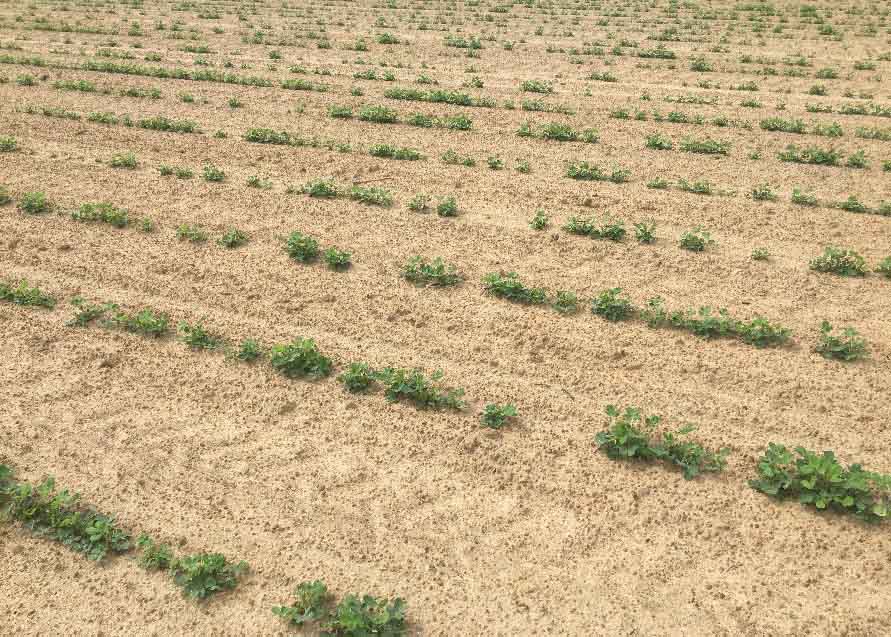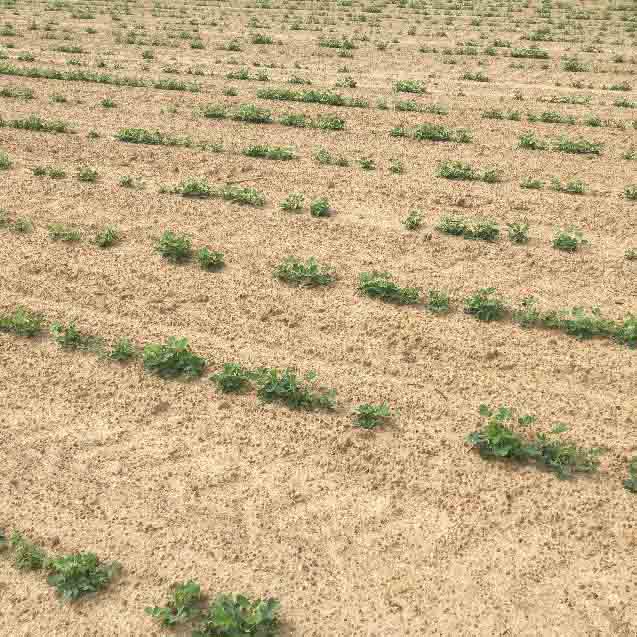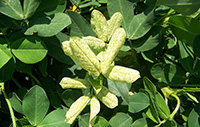Come August, the state's peanut growers will either be reaping the payoff of their spring efforts to control for tomato spotted wilt virus, or they will be planning ways to preventatively manage this persistent virus with recommendations from University of Georgia scientists.
TSWV is a disease that was first discovered in the U.S. in Texas in the 1970s. It did not become a significant disease in Georgia until the 1990s. Since that time, TSWV has become a major issue on a number of important agricultural crops throughout the Southeast, including peanut, pepper, tomato and tobacco. TSWV is transmitted by thrips, which are tiny piercing-sucking insects. Thrips can cause mild to significant damage on their own accord, but their effective transmission of TSWV makes this insect a priority for peanut growers to preventatively control each year.
Thrips are tiny winged insects that feed chiefly on plants. Many species damage cultivated plants by either sucking the sap or transmitting viral plant diseases. Thrips reach a maximum length of about half an inch. Most have two pairs of long, narrow, hair-fringed wings.
“Thrips are the only insect known to transmit this virus,” explained Mark Abney, associate professor of peanut entomology in the UGA College of Agricultural and Environmental Sciences. “Growers can see disease symptoms at any time in the season, but symptoms are often most obvious beginning in August. By that time it’s too late, because most of the virus transmission occurred back in the spring,” cautioned Abney.
As peanut plants emerge in the spring, they are small and susceptible to both thrips damage and TSWV. Direct thrips-feeding injury can stunt plant growth and reduce yields. The symptoms of TSWV are stunting, yellowing of foliage and characteristic “ring spots” on the leaves.
“I will not be surprised if we see an increased incidence of TSWV in peanut this year because lower seed quality and cool, wet conditions at planting have led to poor seed germination and a lot of ‘skippy stands.’ Low seedling density and gaps between plants increase the risk of TSWV infection, though the reason is not completely understood,” said Abney.
Abney says growers should develop a thrips and TSWV management plan prior to planting peanuts every spring.
“Once the seed furrow is closed, few thrips management options and no TSWV management options remain. The most important tool a grower has to reduce TSWV is plant resistance,” explained Abney.
In Georgia, the majority of peanut acreage is planted to runner-type cultivars. The most commonly grown runner-type cultivar is 'Georgia-06G'. While there are many other cultivars with TSWV resistance, none have consistently performed better than 'Georgia-06G' across a wide range of growing conditions. 'Georgia-06G' is a high-yielding peanut that grows well even in adverse conditions.
An in-furrow insecticide is an important part of a thrips management program. Growers have a choice of insecticide active ingredients if reducing thrips injury is the only goal, but phorate, an organophosphate, is the only insecticide proven to reduce thrips injury and the incidence of TSWV. Phorate induces host defense responses in peanut that result in lower TSWV infection rates. Conversely, the insecticide causes phytotoxicity in peanut that some growers find undesirable.
“Thrips will be present in almost every peanut field every year and TSWV is still with us, but decisions about insecticide use are ultimately up to the grower,” Abney said.
Planting date can also have a major impact on thrips pressure and risk of disease transmission. “Planting early can help growers get more yield, but it places them at greater risk for injury from thrips and TSWV,” explained Abney.
Before effective TSWV management tactics were developed by researchers at UGA, planting prior to May 10 was extremely risky. The combination of TSWV-resistant cultivars with cultural management practices means that growers can now plant earlier and still avoid severe losses from TSWV.
“Nevertheless, we don’t want growers to put all their eggs in one basket. A good strategy is to plant some peanuts early, utilizing as many thrips/TSWV management tools as possible, and plant the remainder of the crop after May 10 when the likelihood of infection is lower,” Abney said.
The virus can only survive in living plant tissues or its thrips host. During winter months, the virus survives primarily in winter annual weeds and will return in the spring as thrips migrate and start feeding on newly planted crops.
“Unfortunately, you can’t really reduce the amount of TSWV by managing weeds or other alternate hosts because there are just too many weeds in the environment. So, we don’t recommend developing a weed management program to control TSWV because it’s just biologically not possible,” Abney explained.
Other production practices that affect thrips and TSWV are row pattern and tillage. Peanuts can be planted in either single- or twin-row patterns. The more rapid ground coverage obtained in twin-row plantings can be advantageous for many reasons, not the least of which is a proven reduction in the incidence of TSWV compared to single rows. Residue left on the soil surface where reduced tillage systems are employed can significantly reduce thrips pressure compared to conventionally tilled peanut.
“The development of current thrips and TSWV management recommendations is a great example of how people have worked across disciplines to create effective programs that rely on the integration of a variety of cultural and chemical tools to combat a severe economic pest,” said Abney. “It takes a lot of trial and error, but we’ve really come a long way to provide growers the best up-to-date information to help them navigate this challenging pest-virus relationship.”
To learn more about thrips and TSWV, visit site.extension.uga.edu/peanutent.










